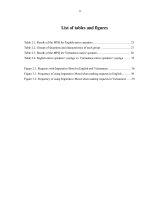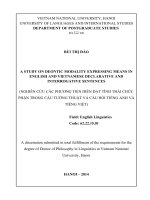Politeness phenomena in English and Vietnamese through using imperative mood within Thang Long University education environment
Bạn đang xem bản rút gọn của tài liệu. Xem và tải ngay bản đầy đủ của tài liệu tại đây (150.94 KB, 5 trang )
Politeness phenomena in English and
Vietnamese through using imperative mood
within Thang Long University education
environment
Nguyễn Vân Khánh
Trường Đại học Ngoại Ngữ
Luận văn ThS. Chuyên ngành: English Linguistics; Mã số: 60 22 15
Người hướng dẫn: Assoc. Prof. Dr. Nguyễn Văn Độ
Năm bảo vệ: 2010
Keywords: Tiếng Anh; Tiếng Việt; Giao tiếp; Hiện tượng lịch sự
Content:
PART A. INTRODUCTION
1. Rationale of the study
English is one of the most important languages in communication. It plays a very important
role in many aspects of everyday life such as: Education, culture, technology, science, etc….
What is noticeable is that learning English becomes an increasing need for many people in
society. They study English for various purposes: for job, for promotion, for going abroad…. In
Vietnam, English is very popular and is being taught widely.
In Vietnam, with the open-door policy of Vietnamese government, English, day by day,
affirms its dominated role for international communication. English is taught compulsory in
many schools in Vietnam. Also, it becomes a compulsory subject in many universities and
schools, for example, Thang Long University. Although English has been taught in Vietnam for
several years but only, grammatical correctness seem to be highly appreciated in teaching. This
way of teaching and learning is not effective enough to provide cultural factors to make cross-
cultural communication successful. Therefore, learners do not know what to say in order to have
a contextual, situational and cultural appropriateness in communication. Even today many
Vietnamese teachers of English still appreciate grammatical correctness over appropriateness in
communication. They still enjoy grammar translation method. As a result, students cannot
communicate orally in an appropriate way despite their rather good linguistic competence.
It is obvious that learning a second language means learning a second culture. To study the
second language, one needs to be provided not only linguistic knowledge and interaction skills
but also cultural knowledge. Nowadays, cultural factors are included in the course design.
However, they are often treated as optional supplement to stimulate interest or improve
background knowledge. Understanding cultural factors is an important key to succeed in learning
English. Although teachers have created more opportunities for them to use English effectively,
Vietnamese students may face with many difficulties in communication because they tend to use
English based on their native culture – Oriental culture. As a result, sometimes, when they
communicate with foreigners, they may make unfriendly or impolite or even rude social
expressions unnoticeablely. So as to communicate well across culture, firstly, learners must
understand deeply about their own culture. Then, they must be aware of the English speaking
culture. They must ensure the hidden parts of culture including politeness. Politeness is a very
important part of social interaction. In order to facilitate students at Thang Long University in
improving their oral communication, the author of this thesis wants to study the politeness
phenomena in English and Vietnamese through using Imperative Mood to make requests.
2. Aims of the study
The study aims to find out:
Do English native speakers use Imperative Mood to make polite requests in the
Educational Environment?
How do Vietnamese teachers and students at Thang Long University use Imperative
Mood to show their politeness when making a request in the Educational Environment?
How do the English native speakers and the Vietnamese native speakers differ in using
linguistic structures to make requests in the social situations studied?
3. Scope of the study
The study focuses on politeness phenomena shown by both English and Vietnamese
speakers who are Vietnamese students and teachers at Thang Long University when using
Imperative Mood to make requests.
4. Structure of the study
This thesis is structured in three parts: Part A – Introduction, Part B – Development and Part
C – Conclusions. Part B is composed of three chapters as follows:
The purpose of Chapter one (Theoretical background) is to introduce the key theoretical
concepts that the study is based on.
Chapter two (A study within ThangLong University Educational Environment) introduces
the questions the present study attempts to answer. It also describes the procedures and
instruments used to collect the data, the participants in the study, as well as the way the data were
analyzed. Besides, a tentative analytical framework is also presented.
Chapter three (Findings and discussions) presents the results of the study and discusses the
differences and similarities politeness phenomena in English and Vietnamese through using
Imperative Mood to make requests.
Finally, part C – Conclusions will summarize the most important findings of the study as
well as present all the limitations, the implications of the study and recommendations for further
studies.
REFERENCES
In English:
1. Beebe, L.M., & Cummings, M.C. (1996), Natural speech act data versus written
questionnaire data: How data collection method affects speech act performance.
2. Bright. W. (1992), International encyclopedia of linguistics (edited), Vol. 4, Oxford
University Press.
3. Brown, H. D. (1986), Learning a second culture, In J.M. Valdes (Ed.), Culture Bound:
Bridging the Cultural gap in Language Teaching (pp. 33-48), Cambridge: Cambridge
University Press.
4. Brown, P. and Levinson, S.C. (1987), Politeness: Some Universals in Language Usage,
Cambridge University Press.
5. Eisenstein, M., & Bodman, J. (1993), Expressing gratitude in American English, In G.
Kasper & S. Blum-Kulka (Ed.), Interlanguage pragmatics (pp. 64-81), New York:
Oxford University Press.
6. Finch. G. (2000), Linguistic terms and concepts, Macmillan Press Ltd, London.
7. FitzGerald, H. (1999), Adult ESL: What culture do we teach? In J. Lo Bianco, A.J.
Liddicoat, & C. Crozet (Ed.), Striving for the Third Place: Intercultural Competence
through Language Education (pp.127-142), Melbourne: Language Australia.
8. Halliday, M.A.K (1994), An introduction to Functional Grammar (2
nd
edition), Erward
Arnold, London.
9. Huddleston, R (1984), Introduction to the grammar of English. London: Cambridge
University Press
10. Nguyễn Văn Độ (1999), Cultural Differences in English Language Training, Teacher’s
Edition, English Language Institute.
11. Lyons, J. (1977:747), Semantics. Vol 2. London: Cambridge University Press.
12. Palmer, F.R (1994), Grammar (2
nd
Ed). London: Penguin.
13. Palmer, F. R. (1986), Mood and modality, Cambridge University Press.
14. Palmer, F.R. (1990), Modality and the English Modals, Longman, London and New
York.
15. Quirk. R and Greenbaum. S (1973), A university grammar of English, Longman.
16. Quirk. R et al (1985), A comprehensive grammar of the English language, Longman.
17. Raines, C.M. (1999), Designing Curriculum to teach American Culture in the ESL
Classroom, PhD. diss., The University of Mississippi.
18. Schumacher, S. & McMillan, J. (1993), Research in Education: a Conceptual
Introduction, New York: Harper and Collins.
In Vietnamese
1. Diệp Quang Ban (2005), Ngữ pháp Tiếng Việt, NXB Giáo dục, Hà Nội.
2. Nguyễn Tài Cẩn (1999), Ngữ pháp Tiếng Việt (Tiếng – Từ ghép – Đoản ngữ), Nhà xuất
bản Đại học Quốc gia Hà Nội.
3. Đỗ Hữu Châu, Bùi Minh Toán (2003), Đại cương ngôn ngữ học, Tập 1, NXB Giáo dục,
Hà Nội
4. Diệp Quang Ban (2005), Ngữ pháp Tiếng Việt, NXB Giáo dục, Hà Nội.
5. Nguyễn Văn Độ (2000), Các phương tiện ngôn ngữ biểu hiện hành động thỉnh cầu trong
Tiếng Anh và Tiếng Việt, Luận án tiến sĩ ngữ văn. ĐHKH XHNV – ĐHQG Hà Nội.
6. Nguyễn Văn Độ, Về việc nghiên cứu lịch sự trong giao tiếp, Ngôn ngữ, số 1, 1995.
7. Nguyễn Văn Độ, Vấn đề văn hóa trong giảng dạy ngoại ngữ ở Việt Nam, Ngữ học trẻ, Hà
Nội, 1996.
8. Đinh Văn Đức (1993), Một vài cảm nhận về ngữ phá chức năng và cách nhìn về ngữ
pháp tiếng Việt, Ngôn ngữ số 3
9. Cao Xuân Hạo (2001), Ngữ pháp chức năng tiếng Việt: Câu trong tiếng Việt, Quyển 1,
NXB Khoa học xã hội, Hà Nội.
10. Ngô Đình Phương (2005), Thành tố nghĩa liên nhân thông qua các phương tiện từ ngữ
biểu hiện nó trong phát ngôn – câu, Luận văn tiến sĩ ngữ văn, Đại học Vinh.
11. Nguyễn Quang (1999), Một số khác biệt giao tiếp lời nói Việt Mỹ trong cách thức khen
và tiếp nhận lời khen, Luận án tiến sĩ ngữ văn. ĐHKH XHNV – ĐHQG Hà nội.
12. Nguyễn Kim Thản (1977), Động từ trong Tiếng Việt, Nhà xuất bản Khoa học Xã hội, Hà
Nội.









